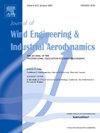Validation of a multivariate non-Gaussian and non-stationary stochastic wind pressure model driven by stationary wind tunnel data
IF 4.2
2区 工程技术
Q1 ENGINEERING, CIVIL
Journal of Wind Engineering and Industrial Aerodynamics
Pub Date : 2025-02-01
DOI:10.1016/j.jweia.2024.105970
引用次数: 0
Abstract
With growing interest in probabilistic assessments of structures subject to extreme winds, there is a need for stochastic simulation schemes that can capture the inherently non-Gaussian and non-stationary (NG–NS) features of wind loads during the simulation of path-dependent phenomena such as inelasticity, fatigue, and cladding damage. Currently, no validated NG–NS stochastic load model exists that can be calibrated to standard wind tunnel data. A recently developed model proposed the stochastic simulation of direction-wise pressures based on standard wind tunnel data, followed by a filter-based transition scheme for generating NG–NS wind load records. Recognizing the importance of validation in creating confidence in a model, this work focuses on extensive experimental validation of the NG–NS stochastic load model. Validation is achieved using data from specifically designed wind tunnel tests, whereby NG–NS records are obtained through continuous rotation of the turntable. Six different rates of change in wind direction, consistent with those expected in hurricanes, are considered with validation based on quantitative time–frequency error analysis using spectrograms, as well as the examination of temporal trends in statistical properties. The results show that the scheme correlates well with the experimental data, with spectrogram-based errors remaining within 10% across all pressure taps and test conditions.
平稳风洞数据驱动的多元非高斯非平稳随机风压模型验证
随着人们对极端风作用下结构概率评估的兴趣日益浓厚,在模拟路径相关现象(如非弹性、疲劳和包层损伤)时,需要一种能够捕捉风荷载固有非高斯和非平稳(NG-NS)特征的随机模拟方案。目前,还没有经过验证的NG-NS随机荷载模型可以根据标准风洞数据进行校准。最近开发的一个模型提出了基于标准风洞数据的方向压力随机模拟,然后是一个基于滤波器的转换方案,用于生成NG-NS风荷载记录。认识到验证在建立模型信心中的重要性,本工作着重于NG-NS随机载荷模型的广泛实验验证。验证是使用来自专门设计的风洞试验的数据来实现的,其中NG-NS记录是通过转盘的连续旋转获得的。根据使用谱图的定量时频误差分析以及对统计特性的时间趋势的检查,考虑了与飓风预期一致的六种不同的风向变化率,并进行了验证。结果表明,该方案与实验数据具有良好的相关性,在所有压力开关和测试条件下,基于谱图的误差保持在10%以内。
本文章由计算机程序翻译,如有差异,请以英文原文为准。
求助全文
约1分钟内获得全文
求助全文
来源期刊
CiteScore
8.90
自引率
22.90%
发文量
306
审稿时长
4.4 months
期刊介绍:
The objective of the journal is to provide a means for the publication and interchange of information, on an international basis, on all those aspects of wind engineering that are included in the activities of the International Association for Wind Engineering http://www.iawe.org/. These are: social and economic impact of wind effects; wind characteristics and structure, local wind environments, wind loads and structural response, diffusion, pollutant dispersion and matter transport, wind effects on building heat loss and ventilation, wind effects on transport systems, aerodynamic aspects of wind energy generation, and codification of wind effects.
Papers on these subjects describing full-scale measurements, wind-tunnel simulation studies, computational or theoretical methods are published, as well as papers dealing with the development of techniques and apparatus for wind engineering experiments.

 求助内容:
求助内容: 应助结果提醒方式:
应助结果提醒方式:


